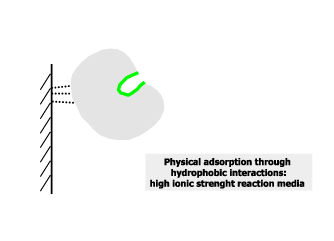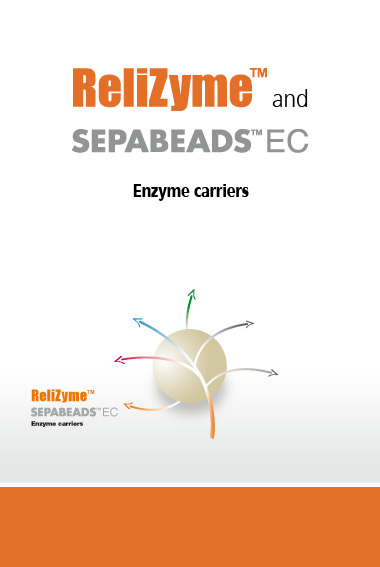
Immobilization mechanisms
The enzyme can be immobilized through several methods such as:
a. INTERACTION WITH THE CARRIER
- Adsorption
- Ionic interaction
- Cross-linking
- Covalent binding with functional group
a. Interaction with the carrier

The enzyme is adsorbed on the carrier at suitable conditions (e.g. pH, salt content) for the interaction with the functional groups distributed on the carrier surface.
The interaction is reversible and the enzyme can be de-adsorbed changing the conditions. In some cases the adsorption can be quite strong (e.g. hydrophobic interaction)
The reversible interaction can take place through:
- Hydrophobic adsorption: Hydrophobic adsorbents e.g. Relizyme™ BU403 or OD403 and SEPABEADS™ EC-BU or EC-OD;
- Ionic interaction: Amino functionalised carriers e.g. Relizyme™ EA403 or HA403 and SEPABEADS™ EC-EA or EC-HA;
b. Chemical binding
The reversible immobilisation can become irreversible by means of a cross-linking step: the enzyme is adsorbed onto the carrier and then crosslinked by using, for example, glutaraldehyde. The crosslinked enzyme molecules cover the carrier like a net:

The elective method to obtain an irreversible immobilization is the covalent binding between the enzyme and the functional groups of the carrier. This immobilization can be performed using carriers with oxyrane groups (e.g. Relizyme™ EP403 or HFA403 and SEPABEADS™ EC-EP or EC-HFA) or with an amino functionalised (e.g. Relizyme™ EA403 or HA403 and SEPABEADS™ EC-EA or EC-HA). In case of amino groups is necessary a pre-activation step with a bifunctional coupling agent, such as glutaraldheyde. Another nethod is the activation of the hydroxyl functional groups of ReliZyme™ HG403 and SEPABEADS™ EC-HG.

Several factors related to the micro-environment surrounding the immobilized enzyme have effects on the efficiency of the immobilized biocatalyst, as it is schematically resumed in this table:
| Matrix features | Effect | Effect on catalytic efficiency |
|---|---|---|
| Functional group type and surface polarity | Enzyme orientation | Active sites availability |
| Porosity | Mass transfer | Turnover rate |
| Functional group type and surface polarity | Reagent or product accumulation | Inhibition phenomena |
| Spacer arm length | Mass transfer; system flexibility |
Stability aand active sites accessibility |



